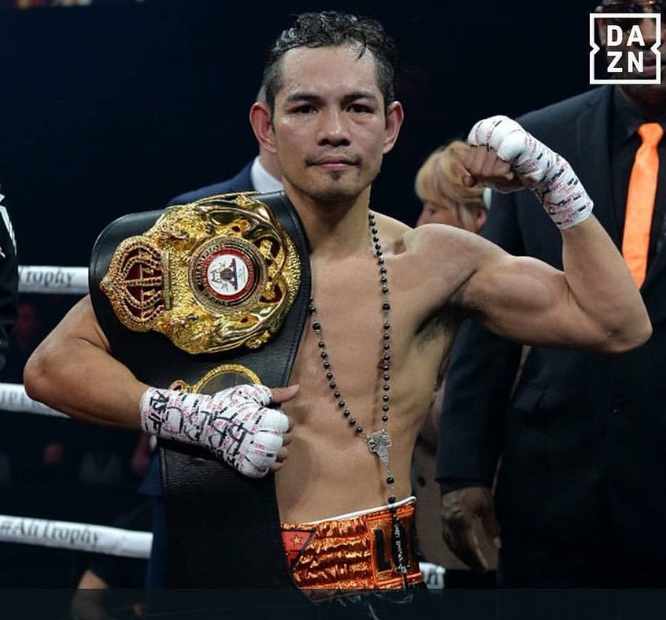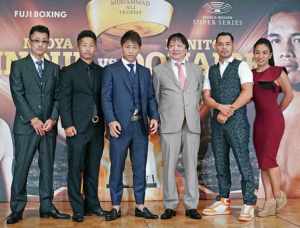Featured Articles
Nonito Donaire says “I’m the Knockout Guy in This Fight”

Japanese sensation Naoya Inoue and Nonito Donaire clash on Nov. 7 in suburban Tokyo at the Saitama Super Arena in the bantamweight finals of the World Boxing Super Series. At stake are WBA and IBF world title belts and the coveted Muhammad Ali Trophy. Inoue, nicknamed “Monster,” is a heavy favorite.
Nonito Donaire, who turns 38 the week after the fight, has won world titles in four weight classes: 112, 118, 122, and 127. Some day in the future he will, almost assuredly, be enshrined in the International Boxing Hall of Fame. But – and although he has been stopped only once in 45 fights, that as a featherweight – hardly anyone likes his chances to stay upright on Nov. 7.
To say that Naoya Inoue has been impressive in his recent outings would be an understatement. His last three fights against title-holders Jamie McDonnell, Juan Carlos Payano, and Emmanuel Rodriguez lasted only six minutes and 21 seconds in the aggregate. None of the three had been stopped before. Payano and Rodriguez had never been dropped.
The noted Scottish boxing historian Matt McGrain has been unstinting in his praise. “The pathology of his violence is exquisite,” said McGrain of Inoue in a story that ran on these pages. “He is a watching, waiting, learning doom-machine that appears to have been programmed by Carlos Zarate.” (Note: Zarate scored 63 knockouts in his 70-bout career.)
Inoue’s triumph over Payano, which took him all of 70 seconds, was feted by a cover story in The Ring magazine, making the baby-faced assassin the first Japanese fighter to appear on the magazine’s cover in the 119-year history of that august publication. If Inoue (18-0, 16 KOs) can reprise the wow factor vs. Donaire, he will likely be named the 2019 Fighter of the Year in all the year-end polls – unless Andy Ruiz can repeat his upset of Anthony Joshua, in which case the voters will have a thorny dilemma.
Nonito Donaire, the Filipino Flash, is nonplussed. A pro since 2001, Donaire (40-5, 26 KOs) is confident that he can derail the Inoue Express.
“People seem to have forgotten that I have a knockout punch too,” says Donaire. “In my mind, if knockouts are going to be the theme of the promotion, I should get top billing.”
Indeed, he certainly does have a knockout punch. His brutal knockouts of Vic Darchinyan in 2007 and Fernando Montiel in 2011 were named Knockout of the Year by the aforementioned The Ring. And his knockout of late sub Stephon Young in his most recent start is a candidate for that honor again. In the sixth round of their fight in Lafayette, Louisiana, Donaire knocked Young out cold with a thunderous left hook.
Donaire may have gotten a break when his second-round opponent Zolani Tete was forced to withdraw with a shoulder injury, but it’s worth noting that he was the underdog going into this tournament. Top seed Ryan Burnett had his pick of the four unseeded entrants and chose Donaire, effectively making Donaire the eighth seed of an eight-man tournament.
Donaire could see the logic. The undefeated (19-0) Burnett, reportedly 94-4 as an amateur, was the younger man by almost 10 years. Donaire would be coming down in weight; almost seven years had elapsed since he had last fought as a bantamweight. His recent showings, he readily admitted, were lackluster. He was outpointed by Jessie Magdaleno and Carl Frampton in fights spaced 17 months apart. And finally, the fight would be in Glasgow, a regional site advantage for Burnett, an Irishman from Belfast.
In the fourth round, Burnett took a knee after apparently suffering a lower back injury after throwing a right hand. He retired on his stool after that round and was stretchered out of the ring. The conventional version is that he suffered a freak injury and Nonito is perfectly fine with that narrative. “People are entitled to their opinion,” he says nonchalantly.
Outside the ring, Donaire isn’t a fighter, but the same can’t be said for his manager who is insistent that Burnett’s injury was caused by a body punch and that Burnett was stretchered out of the ring to save face, thereby denying her husband his proper due.
Yes, Donaire’s manager happens to be the woman that he sleeps with, the mother of their two children, boys aged six and four. She’s not only his manager, but his strength and conditioning coach. “She pretty much runs everything,” says Donaire. “She’s 99 percent the boss.”
Nonito Donaire was born in the Philippines in the same town where Manny Pacquiao was born, the third youngest of four children. His parents left him and one of his siblings with his grandparents when they migrated to the United States, sending for them as soon as his father, a welder, could afford their passage. He arrived in the U.S. at the age of 10 and grew into adulthood in San Leandro, a community on the east side of the San Francisco Bay.
Donaire won his first title in 2007 with his explosive knockout of Darchinyan. Later that year, at a Bay Area club, he met Rachel Marcial, his future wife. She had spent five years in the U.S. Air Force and was a big name in the sport of Taekwondo, having won numerous military and civilian titles. Since 2011, their primary home has been in Las Vegas.
Rachel Marcial Donaire doesn’t fit the stereotype of a female prizefighter with a military background. In 2012, the pert Filipina-American was named the 38th sexiest woman on the planet in the Filipino edition of the popular international men’s magazine FHM in their annual listing of the 100 sexiest women in the world. As power couples in boxing go, Nonito and Rachel are the second-most “paparazzi-ed” in the Philippines, trailing only Senator Manny and Jinkee.

Rachel (pictured on the far right beside her husband at a Tokyo press conference) believes her Air Force background was hugely advantageous in preparing her for her role as the boss of Team Donaire. “It helped me to be very good at having an attention to detail, not letting things slide. Especially with Nonito’s camp, we have become a very efficient team because of the way I was brought through in the military,” she told David Kelly, a writer for the Belfast Telegraph.
Beginning with his father, Nonito has had several boxing coaches over the years. For a time, he was with the Cuban globetrotter Ismael Salas. That didn’t work out and now he’s with old salt Kenny Adams who is perhaps best known as the head trainer of the 1988 U.S. Olympic boxing team that won eight medals in Seoul. Nonito’s relationship with his father has been rocky at times, but things are now copacetic and dad will be in the corner with Adams on Nov. 7.
Earlier this week, this reporter attended a workout by Donaire held behind a closed curtain at the City Boxing Club in Las Vegas. It was a vigorous workout with few dead moments that included a zesty sparring session with South African toughie DeeJay Kriel. Later that afternoon, Donaire had another workout scheduled at a park that involved exercises customized for him by Rachel, a certified fitness instructor. One doubts that even professional triathletes are as well-conditioned.
Team Donaire shifts its training camp to the Philippines on Oct. 18. (Tokyo is 16 hours ahead of Las Vegas but only one hour ahead of Manila, an important consideration.) Then it’s off to Japan for the bout that will be contested in that nation’s largest indoor stadium. The promoters, say Rachel, anticipate a crowd somewhat north of 20,000.
Regardless of the outcome, Donaire says he has no plans to retire any time soon. “This division (118) is where I belong,” he says. “It’s always where I felt most comfortable. I love boxing and I am very healthy.”
Inoue vs. Donaire will air live in North America on DAZN. The odds are skewed heavily in favor of the local guy, but it’s yet a very compelling fight.
Check out more boxing news on video at The Boxing Channel
To comment on this story in The Fight Forum CLICK HERE
-

 Featured Articles4 weeks ago
Featured Articles4 weeks agoThe Hauser Report: Zayas-Garcia, Pacquiao, Usyk, and the NYSAC
-

 Featured Articles3 weeks ago
Featured Articles3 weeks agoOscar Duarte and Regis Prograis Prevail on an Action-Packed Fight Card in Chicago
-

 Featured Articles2 weeks ago
Featured Articles2 weeks agoThe Hauser Report: Cinematic and Literary Notes
-

 Book Review2 weeks ago
Book Review2 weeks agoMark Kriegel’s New Book About Mike Tyson is a Must-Read
-

 Featured Articles4 weeks ago
Featured Articles4 weeks agoRemembering Dwight Muhammad Qawi (1953-2025) and his Triumphant Return to Prison
-

 Featured Articles7 days ago
Featured Articles7 days agoMoses Itauma Continues his Rapid Rise; Steamrolls Dillian Whyte in Riyadh
-

 Featured Articles3 weeks ago
Featured Articles3 weeks agoRahaman Ali (1943-2025)
-

 Featured Articles3 weeks ago
Featured Articles3 weeks agoTop Rank Boxing is in Limbo, but that Hasn’t Benched Robert Garcia’s Up-and-Comers



















